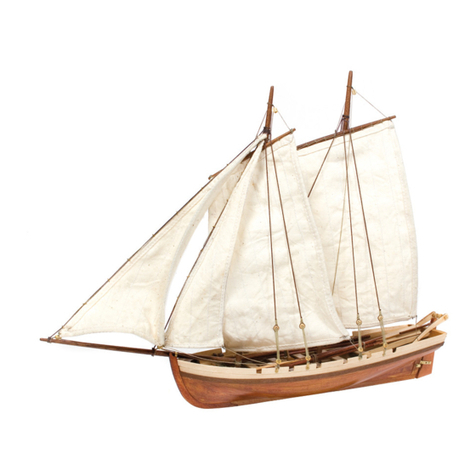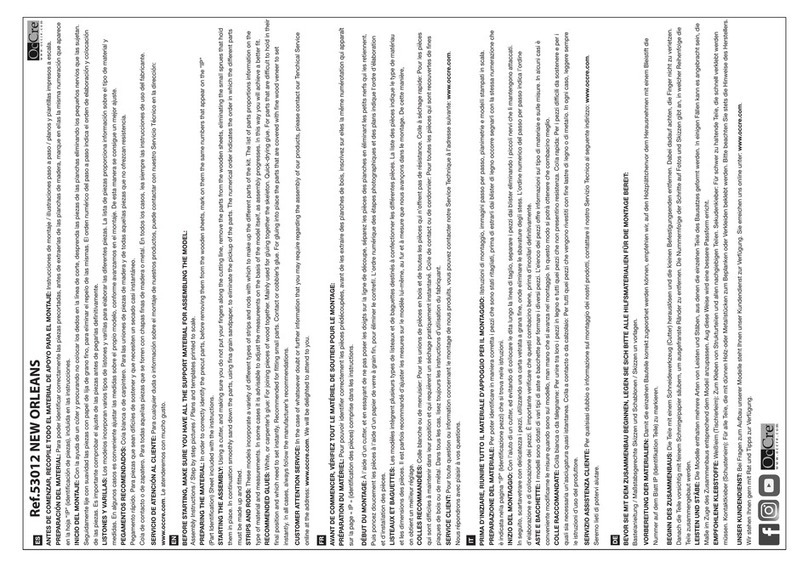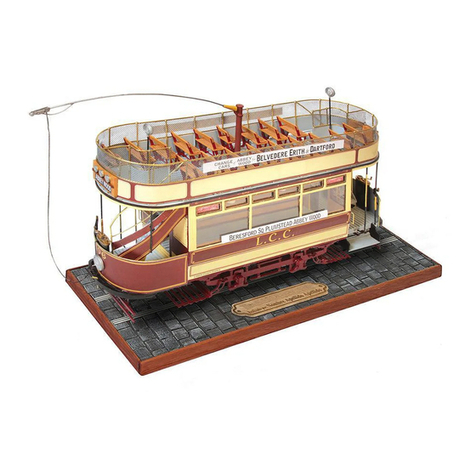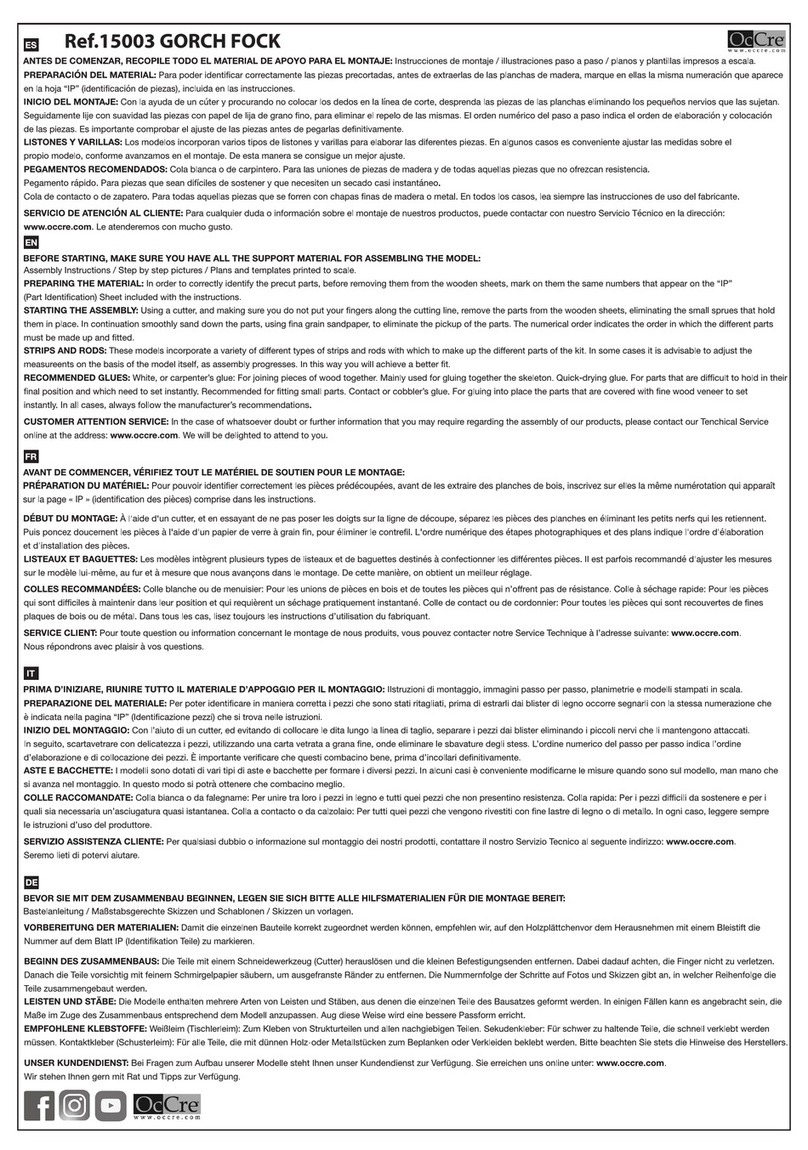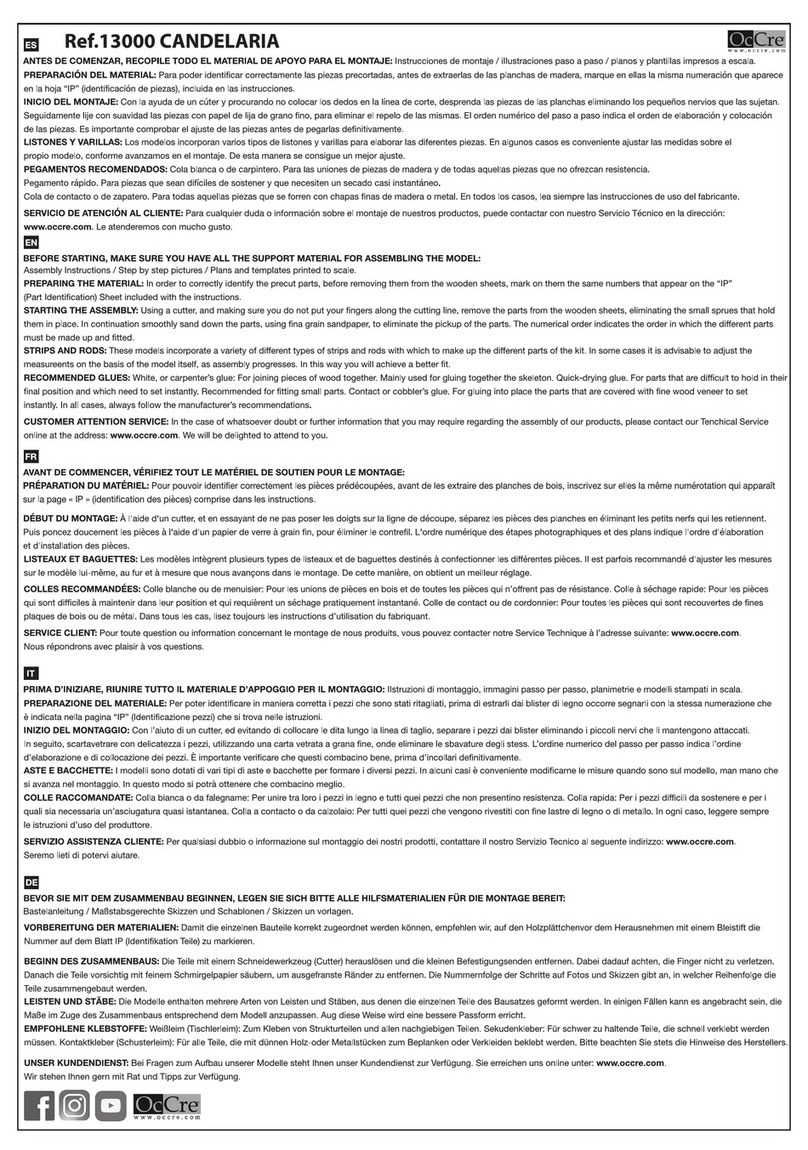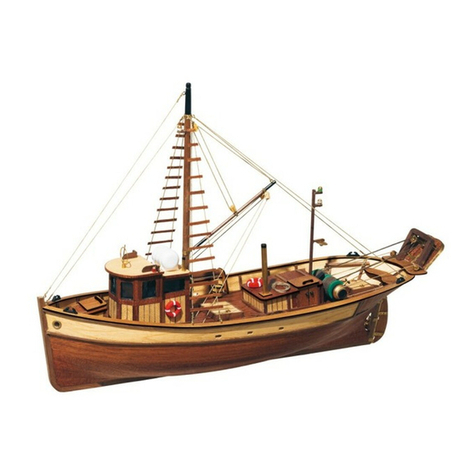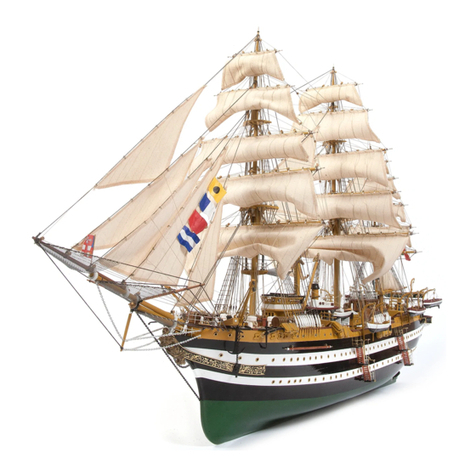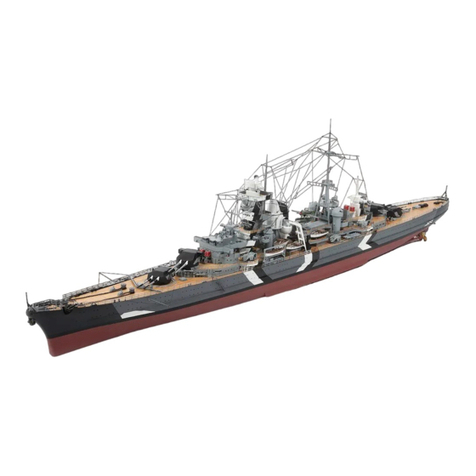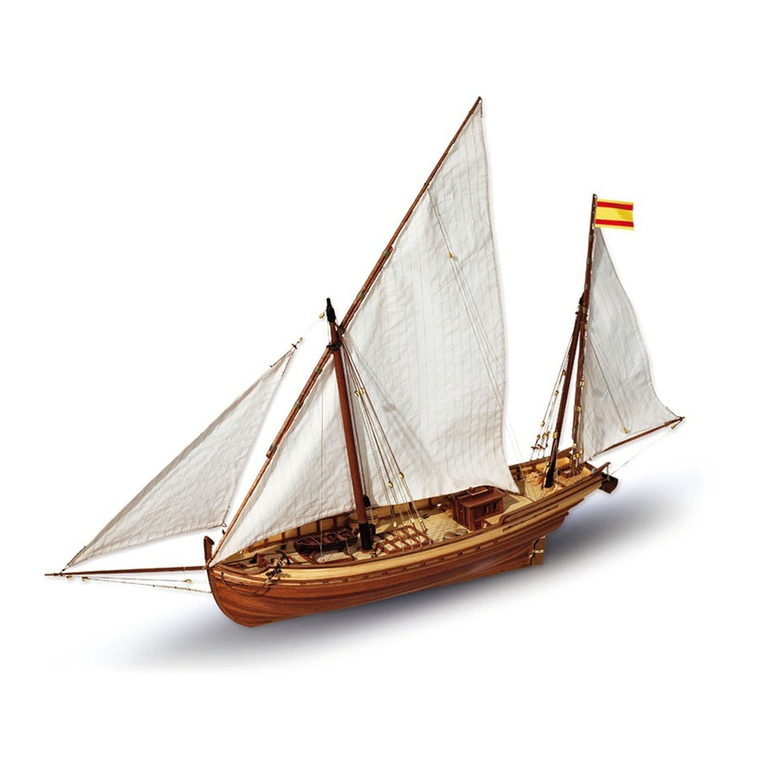INSTRUCCIONES DE MONTAJE TITANIC
A. Utilice una superficie plana y estable para pegar las piezas A1 y A2, y refuerce su unión con las piezas A3. Siguiendo el orden alfanumérico inserte y pegue las piezas indicadas en las
figuras. Antes de encolar las cuadernas, verifique que encajan correctamente en su posición haciendo “tope” en los encajes correspondientes de la falsa quilla. Es importante que las
cuadernas queden completamente perpendiculares a la falsa quilla para que posteriormente encajen bien las cubiertas. Para esta operación utilice como adhesivo cola blanca, (Ref. 19200).
B y C. Utilice las cubiertas para alinear y pegar las piezas de las estructuras que muestran las imágenes. Para esta operación utilice cola blanca, (Ref. 19200). Después, retire las
estructuras de las cubiertas y aplique masilla tapa-grietas para tapar las uniones. Cuando la masilla se haya secado, lije los conjuntos para unificar sus superficies. Si no dispone de una
lima plana, puede construir una pegando un papel de lija sobre una porción de listón. Después, aplique pintura de color blanco, (Ref.19300). Puede aplicar la pintura a pincel o con
aerógrafo, siendo éste último con el que obtendrá un acabado óptimo.
D. Trace una línea longitudinal que divida la cubierta B1 en dos mitades. Comience a forrar ajustando la primera chapa a la línea de lápiz. Pegue las chapas muy juntas para que no se
noten las uniones. Utilice como adhesivo cola blanca, (Ref.19200). Presione las chapas contra la cubierta para que se adhieran con firmeza. Es aconsejable, colocar algún objeto pesado y
plano encima hasta que la cola se seque. Después, coloque la cubierta bocabajo y corte los sobrantes de las chapas con un cúter. Lije la cubierta hasta dejar su superficie fina y
homogénea. Después, elimine el polvo resultante del lijado y aplique un par de capas de barniz satinado, (Ref. 19209), lijando entre una y otra. Proceda de la misma manera con las
cubiertas B9, B16 y D2. Presente las cubiertas C1, C10 y C22 sobre una superficie plana. Sitúe las estructuras que ya tiene construidas para comprobar su ajuste. Después, pegue las tres
cubiertas entre si y retire las estructuras. Lije y forre la cubierta obtenida con las chapas D3. Después, lije y barnice la cubierta.
E y F.Aplique cola blanca, (Ref.19200), y pegue las estructuras sobre las cubiertas de forma definitiva. Utilice un lijador plano para igualar la parte superior de las estructuras. Utilice un
cúter para sacar las decoraciones de la hoja que las agrupa. Coloque las decoraciones siguiendo las indicaciones de las fotos. Estas decoraciones son autoadhesivas y vienen ya
recortadas. Utilice un listón plano o un bastoncillo de algodón para presionarlas y que se fijen con firmeza. Presente las cubiertas sobre el esqueleto para comprobar su ajuste. Después,
péguelas cómo le indican las imágenes.
G. Coloque el casco boca abajo y comience a lijar empezando desde proa y avanzando hacia popa. Debe desbastar las aristas de las cuadernas pero sin deformar su forma original. El
lijado del casco ha de quedar simétrico, es decir, que el lateral derecho ha de quedar igual que el izquierdo. Para la zona media del casco, utilice un taco lijador con mayor superficie. El
lijado debe ser progresivo y suave. Compruebe con un listón, que el lijado es correcto. Para ello, debe deslizar el listón, sobre las cuadernas, para ver como se ajusta a su forma.
H. Lije las piezas H1 y H2 con papel de lija fino. Después, sumérjalas en agua durante unos 20 minutos. Utilice algún objeto cilíndrico para curvar poco a poco las piezas. Debe presionar la
pieza colocando los dedos muy juntos para evitar que se rompa. Utilice cinta de pintor para aislar las zonas de las piezas y píntelas de color blanco, (Ref. 19300). Después, coloque y pegue
las piezas en el casco con pegamento rápido.
I a K. Comience el forrado del casco con los listones i1. Si los listones estuvieran muy secos y se le rompen al curvarlos, sumérjalos en agua unos veinte minutos. Con esta operación,
recuperarán flexibilidad. Después, séquelos con un paño. Debe ajustar la longitud del primer listón y pegarlo con cola blanca, (Ref. 19200), entre las piezas H1 y H2.. Observe las imágenes
siguientes antes de proceder. Los demás listones del forro debe pegarlos a las cuadernas y entre sí, con cola blanca y fijarlos con puntas. Continúe pegando listones desde proa hasta popa
para forrar el casco entero. Deberá cortar a medida y ajustar las piezas para que encajen en los huecos. Si en algún punto le ha quedado algún listón suelto, puede aplicar pegamento de
secado rápido. Si le ha quedado algún listón más hundido, pegue otro encima y después, líjelo. Lime las cabezas de las puntas con una lima plana hasta que queden enrasadas con el forro.
Pegue los refuerzos K2 a K5 en la zona de popa del casco. Diluya un poco de cola blanca con agua para que pueda aplicarla ligeramente y se filtre entre las juntas de los listones. Reserve
el casco hasta que la cola se seque. Con esta operación se unificará el forro del casco ganando así consistencia. Después, lije todo el casco. Debe quedar suave y sin desniveles.
L. Aplique una capa de masilla tapa grietas a toda la superficie del forro del casco. Cuando se seque, líjelo todo para dejarlo fino y sin desniveles. Lije y pinte las piezas L1 a L4 de color
blanco, (Ref.19300). Ajuste y pegue las piezas L1 y L2 con pegamento de secado rápido. Proceda de la misma manera para pegar las piezas L3 y L4 en el otro lado del barco. Corte a
medida y pegue las piezas L5 a L7 y lije para suavizarlas.
M y N. Utilice cinta de carrocero para enmascarar las zonas de la estructura del casco y dejar descubierto el forro. Aplique una imprimación a toda la superficie. Es recomendable utilizar
spray, y a ser posible de color gris. Ésta permitirá ver los posibles defectos del forro. Después de aplicar el producto, lije el casco de nuevo. Corrija las imperfecciones con masilla y repita el
proceso hasta dejar un casco fino. Aplique pegamento rápido y pegue las piezas M1 a M34. Utilice la plantilla PL-01 para identificar las piezas y su posición en el casco. Utilice como
separador la pieza M35. Esta pieza le servirá para mantener las piezas paralelas entre si. Después, vuelva a enmascarar el casco y aplique imprimación, con esta operación, las piezas M1
a M34, sacarán un repelo que debe volver a lijar. Utilice papel de lija o esponja-lija de grano fino. Pegue las piezas N1 a N9. Para esta operación utilice cola blanca, (Ref. 19200) y pinzas.
O a R. Elabore y añada al casco las piezas que le indican las imágenes. Enmascare la parte superior del barco para reservarlo de la pintura. Pinte el casco con pintura de color negro, (Ref.
19301), y resérvelo hasta que se seque. Para hallar la línea de flotación, sitúe el casco sobre una superficie plana e inmovilícelo. Utilice un lápiz y un taco de madera o similar para marcar la
línea a todo el perímetro del casco. Enmascare de nuevo y pinte de color marrón rojizo, (Ref. 19308). Elabore y pinte la pieza O2 con los mismos colores del casco. Pinte las hélices de color
oro, (Ref. 19380). Pegue las piezas O2 a O5 en el casco. Continúe añadiendo piezas al barco, algunas deberá colocarlas ya pintadas. Pinte las piezas Q5 de color ocre y péguelas al barco.
Para conseguir el color ocre, mezcle los colores amarillo, (Ref. 19306), con unas gotas de marrón, (Ref. 19307), y marrón, (Ref. 19308).
Algunas piezas deberá pintarlas de color negro, (Ref. 19301), y destacar sus relieves con pintura de color plata, (Ref. 19382).
S a W. Forre las cubiertas de la superestructura, líjelas y barnícelas. Construya las estructuras y aplíqueles masilla para tapar las uniones. Después, píntelas de color blanco, (Ref. 19300), y
gris, (Ref. 19302), cómo muestran las imágenes. Añada las piezas y decoraciones siguiendo las indicaciones de las fotos y la plantilla PL-01. Construya las cuatro chimeneas encajando y
pegando las piezas correspondientes. Observe que hay tres medidas diferentes de chimenea. Píntelas de color negro, (Ref. 19301), y color ocre.
X a Z. Pinte las piezas X21 y X22 de color verde, (Ref.19314), y negro (Ref. 19301), y oscurézcalas con pintura marrón, (Ref. 19307). Las piezas X23 deberá pintarlas de color marrón, (Ref.
19307). Las piezas Y25 deberá pintarlas de color blanco, (Ref. 19300), y color amarillo, (Ref. 19306). Las piezas Y21 y Z5 deberá pintarlas de color blanco, (Ref. 19300), y rojo, (Ref.
19310). Para elaborar las piezas Z58, Z59 y Z60, coloque tres piezas Z57 sobre una cinta de carrocero. Recorte y pegue encima las figuras de la plantilla y corte las chapas con la forma
indicada. Después, añada las piezas B, y pinte de color ocre. Complete el barco añadiendo las piezas que le indican las imágenes.
ARBOLADURA
Para elaborar los mástiles, el primer paso a seguir será cortar las varillas según las medidas que indica la lista de piezas, o bien tomarlas directamente de los planos que están impresos a
escala 1/1.
Todos los mástiles y vergas tienen cierta conicidad que se deberá realizar.
Para realizar la conicidad a los mástiles, lije las varillas, (con un lijador), aumentando el desgaste de ésta a medida que se acerca al extremo donde se quiere disminuir el diámetro.
Haga rodar la varilla para que el desgaste sea igual por todo el contorno hasta conseguir llegar al diámetro que indica el plano.
Para elaborar la conicidad de las vergas, realice las mismas operaciones, pero esta vez a ambos extremos de la varilla.
Deberá teñir o pintar las varillas en función del modelo que esté construyendo.
Para realizar correctamente los mástiles de este modelo se deberá tener en cuenta:
-Los planos
-Las fotos de detalle de los mástiles
-Las medidas y descripción de materiales de la lista de piezas
-Las hojas “IP” de identificación de piezas
-La plantilla PL-01
Los mástiles se deberán barnizar y algunas de las piezas que los componen se deberán pintar. Véanse las fotos generales de detalle de los mástiles.
Una vez montados y barnizados, deberán colocarles los aparejos, (estrobos, cuadernales, cáncamos, motones, etc.), y fijarlos al barco.
Los mástiles se deben introducir hasta hacer tope en los encajes de la falsa quilla.
JARCIA
Para elaborar la jarcia de este barco, siga el orden alfabético de las figuras impresas de los planos, que indican el orden de colocación: de hilos, vigotas, motones, velas, etc, destacados en
color rojo. La lista de piezas le orientara sobre el tipo de materiales y medidas a utilizar.
Para simular el envejecido de las velas, se les puede dar un baño con infusión de té, sin hacerlas hervir, y dejarlas secar bien arrugadas.
Se colocaran sin planchar para que tengan cuerpo.
